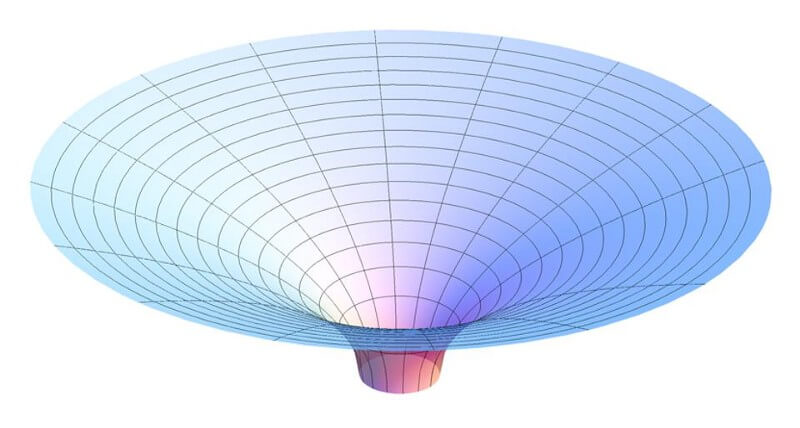
Once an object falls into a black hole, to leave her, he can not. No matter how much energy you have, you will never be able to move faster than the speed of light and overcome the event horizon from the inside. But what if you try to trick this little rule and dip a tiny object in the event horizon, tying it to more massive, which can leave the horizon? Is it possible to get something out of the black hole in any way? The laws of physics are strict, but they are required to answer the question whether it is possible or not. Ethan Siegel from Medium.com offers to find out.
A black hole is not just a superdense and supermassive singularity, in which space bent so much that all trapped inside to get out. Although usually we believe it black hole — actually a region of space around these objects, from which no form of matter or energy — even light itself — can escape. It’s not so exotic as one would think. If you take the Sun as it is, and compress it to a radius of several kilometers, it will turn almost a black hole. Although our Sun is not facing such a transition, the Universe has stars that leave behind these mysterious objects.
The most massive stars in the Universe — stars in twenty, forty, a hundred, or even 260 solar masses — the blue, hot and bright objects. They also burn nuclear fuel in their interior faster than the other stars: for one or two million years is many billions as the Sun. When these inner cores, ending the nuclear fuel, they become hostages of the powerful gravitational forces so powerful that, in the absence without the incredible pressure of nuclear fusion, which they are opposed, they are just quanta collapse into the dark. In the best case, the nuclei and the electrons gain so much energy that merge in a mass of neurons connected together. If this core is more massive than a few suns, these neutrons will be sufficiently dense and massive that quanta collapse into the dark black hole.
Now, remember, the minimum mass for a black hole is a few solar masses. Black holes can grow from a much large masses, merging together, devouring matter and energy and seeping in the centers of galaxies. In the center of the milky Way was a found object, which is four million times the mass of the Sun. In its orbit it is possible to identify individual stars, but any light of any wavelength is not emitted.

Other galaxies have more massive black holes, the mass of which is thousands of times more of our own, and there is no theoretical upper limit to the size of their growth. But there are two interesting properties of black holes, which can lead us to the answer to the question posed at the beginning: is it possible to take something “on a leash”? The first property relates to what is happening with space as the black hole grows. The principle of black hole is that no object can escape from its gravitational pull in space, no matter how accelerated, even moving at the speed of light. The boundary between where the object can escape a black hole and where it cannot is called the event horizon. It is every black hole.
You will be surprised, but the curvature of space is much less in the event horizon of the most massive black holes increases from less massive. Think about it: if you “stood” on the event horizon, putting your right foot on the edge and pushing on the head of 1.6 meters from the singularity, your body would be stretched force — this process is called “spaghettification”. If this black hole were the same as in the center of our galaxy, the tensile strength was only 0.1% of the gravitational force on the Earth, if the Earth itself would become a black hole, and you were there, the tensile force in 1020 times would exceed the earth’s gravity.
If these tensile forces are small at the edge of the event horizon, they are not much more inside the event horizon, and that means considering electromagnetic forces that hold solid objects in integrity — perhaps we could implement his plan: to dip an object in the event horizon and almost immediately removed. Is it possible to do so? To understand, let us consider what happens at the boundary between neutron star and a black hole.

Imagine that you have an extremely dense ball of neutrons but a photon on its surface can still escape into space and do not have to return to the neutron star. Now let’s put on the surface of another neuron. Suddenly the core can no longer resist gravitational collapse. But instead of thinking about what is happening on the surface, let’s think about what is happening inside, where a black hole. Imagine an individual neutron composed of quarks and gluons, and imagine how the gluons need to move from one to another quark in the neutron to the ongoing process of exchange forces.
Now one of these quarks is closer to the singularity in the center of a black hole, and the other on. To exchange forces and the neutron were stable — gluon at some point must move from the middle to the far quark. But it is impossible even at the speed of light (and the gluons have no mass). All the null geodesic, or path of the object moving at the speed of light, will lead to the singularity in the black hole. Moreover, they will never go farther from the singularity of a black hole than at the time of emission. That’s why a neutron inside the event horizon of a black hole must collapse and become part of the singularity in the center.
So back to the example of leash: you took a small weight, tied it to the larger ship; the ship is outside the event horizon, and the weight shipped. When any particle will cross the event horizon, it will not be able to leave — no particle or even light. But photons and gluons remain the very same particles that we need to exchange forces between the particles, which are outside the event horizon, and they also are unable to go anywhere.

This does not necessarily mean that the rope will break; rather, the singularity will delay the whole ship. Of course, tidal forces, under certain conditions, will not tear you apart, but reaching the singularity will be inevitable. The incredible power of attraction and the fact that all the particles of all masses, energies and velocities will have no choice but to go to the singularity, here’s what will take place.
So unfortunately, out of the black hole until he found the exit after crossing the event horizon. To reduce the losses and cut what you already got in, or stay and drown. The choice depends on you.
Is it possible to get something out of the black hole?
Ilya Hel